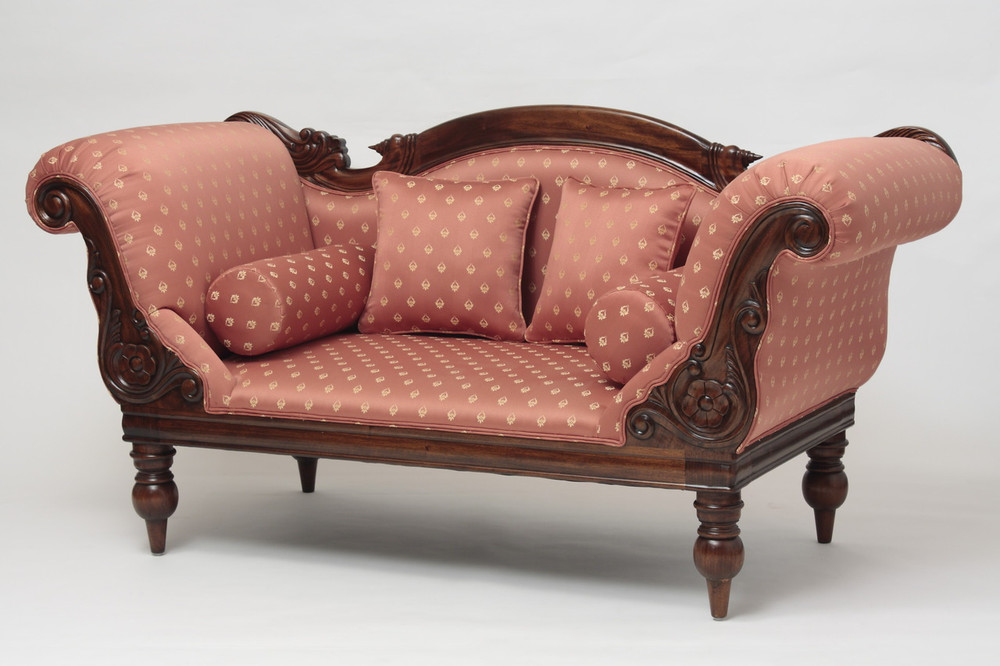- Home
- Learn About Antique Furniture and Reproductions
- Resources
- How to Clean a Sofa
How to Clean a Sofa
Accidents happen in every home and we can also be forgetful when it comes to cleaning upholstered furniture on a continual basis. Whether you are trying to remove a couple of stains from your sofa or you want to perform a deep clean to restore your sofa to pristine condition, this guide will point you in the right direction. With nearly 30 years of experience in handcrafting upholstered antique reproductions and custom furniture, we know a thing or two about how to clean a sofa. This guide will teach you step-by-step how to clean depending on the type of sofa and upholstery you have.
How to Clean a Sofa
No matter how hard you try to keep your upholstered sofa clean, crumbs can find their way into every crevice and that’s not all you have to worry about. Children, pets, and other factors can have a significant impact on the way your sofa looks after a few weeks, months, or years of use. Fortunately, cleaning your sofa is not an impossible feat. We will address some of the most problematic areas to help you find the right solution for your cleaning needs. Before you start, you should always check the manufacturer’s recommendations to ensure that products and techniques are safe.
-
Clean with Haste: As soon as a spill happens or a stain starts forming, start cleaning as soon as you possibly can. Within a matter of minutes, a stain can set and become much more difficult to get out. Reacting quickly will help you stand the best chance of successful stain removal. In the event of an immediate stain, try soaking up as much of the liquid as you can by gently pressing an absorbent rag or towel onto the stain. In the case of fabric sofa materials, you can typically use a mild detergent or upholstery cleaner to dab at and spot clean most stains.
-
Prepare the Sofa: Baking soda can be an effective cleaning treatment if you use it preventatively. Sprinkle baking soda over the entire sofa, which will help to remove any odors and loosen any stains before you start cleaning.
-
Loose Particles: You can use something as simple as a dry brush to remove loose particles, such as pet hair and crumbs. Look for a stiff brush with natural bristles to help loosen any stains as well as bring dust or dirt to the surface for easier access. You can then vacuum the upholstery, moving it from left to right in overlapping lines.
-
Machine Wash: If the material of your sofa is colorfast, pre-shrunk, and machine washable according to the manufacturer, you can remove any loose fabric, such as arm covers or cushion covers, before deep cleaning the sofa by hand. We recommend using a delicate, low-temperature setting and a mild upholstery detergent. You should never dry slipcovers. Instead, you should dry them on a tumble or fluff setting and let them air dry to finish.
-
Steam Cleaning: A handheld garment steamer or even a steam iron can be a surprisingly versatile tool when it comes to removing difficult stains. We recommend that you perform a spot test on a small area of the sofa before you start steam cleaning to prevent any permanent damage or check for discoloration. Choose an area that is out of sight or difficult to see. You should vacuum the sofa before you start steaming. If your handheld steamer comes with a microfiber cloth to help pick up debris, you will want to regularly change them to ensure that all dirt is removed. On a nice day, you can open the windows to help your steam-cleaned sofa dry or you can point a fan on the sofa to help it dry completely. You should deep clean your sofa at least once every year or as often as needed.
Don’t automatically assume that you can use water to clean your sofa. In fact, some pieces of upholstered furniture call for solvent-based cleaners and nothing else. As a rule of thumb, you should never deviate from the manufacturer’s recommended cleaning methods. Sofas usually come with tags, so you have everything you need to know about cleaning. There are four letters used to let you know how a material should be cleaned. A “W” means that you can clean the material using water or water-based cleaners. An “S” means that you should clean the material using a special solvent-based product. A “WS” means that you can clean the material using water-based and solvent-based cleaners. An “X” means that you should only vacuum the material. Now that you know how to clean a sofa, you should be able to keep your upholstered furniture free of stains and clean any contaminants as often as desired. At Laurel Crown, we offer an assortment of upholstery fabrics to choose from and an array of custom furniture services that allow you to take the reins on your own design. Please feel free to contact us with any questions or concerns about this guide.










